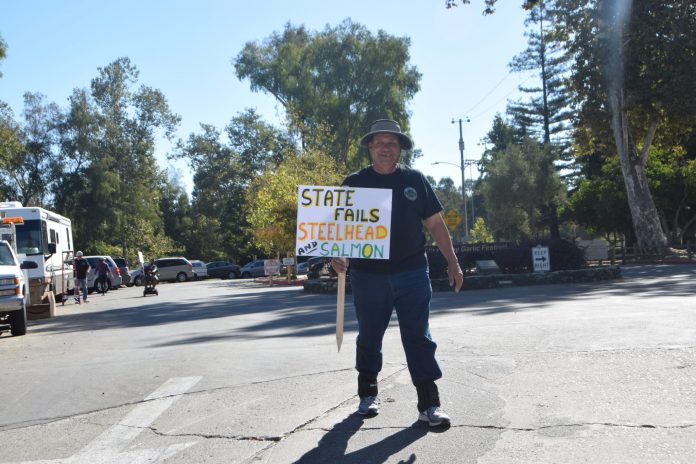
Feet, don’t fail those fish now.
Herman Garcia, the founder and primary driver of CHEER, Coast Habitat Education and Environmental Reform, set off Oct. 13 on a solitary journey of over 150 miles—from Gilroy, on foot, all the way to the State Capitol in Sacramento—to protest state policies about the Steelhead Trout.
Garcia’s journey began at Christmas Hill Park in Gilroy early Saturday morning after a kickoff rally attended by CHEER volunteers, supporters, and State Assembly candidate Robert Rivas. Standing on top of a makeshift podium, Garcia, 71, laid down the gauntlet challenging the state to recognize CHEER’s active role in rescuing stranded Steelhead in regional waterways.
Since 2006, Garcia and his CHEER volunteers have waded into dried up rivers and streams, rescuing young trout stranded on shallow pools as seasonal waters went dry. In 2016, that ongoing mission came to an abrupt end when the state of California barred CHEER from scooping the stranded fish from certain death,to relocate them to free flowing waters in various tributaries of the Pajaro River watershed.
In 2016 the State of California Fish and Wildlife Department suspended the licenses of all non-governmental agencies involved in rescue work unless they are accompanied by a state-certified biologist.
The state’s rationale doesn’t hold much water according to Garcia.
“While we wait, fish die,” Garcia said.
CHEER doesn’t limit itself to saving fish. The group works to reclaim and restore watersheds decimated by toxins and pollution. The work began in 2006, and produced what Garcia described as “best practices,” which yielded tangible results.
“In 2008 the Steelhead and salmon population in the whole northwest tanked, anywhere between 80, 90, to 100 percent of the population was lost,” Garcia said. “We were able to rescue 23,512 fish that year. When everyone else went through the floor, we went straight up, and that’s because of our best practices.”
As of today, Garcia is on the road, walking, he hopes, up to 10 miles a day. Garcia hopes to finish his trek within two weeks, health permitting, and Garcia has a lengthy record of medical maladies.
“I’ve been shot twice, stabbed 24 times, and had 17 concussions, that’s why I’m disabled, it’s a neurological disability,” Garcia said. “I never worry about that stuff. And that was doing good stuff, not bad stuff. I was doing crime fighting work for law enforcement agencies.”
Despite all the physical ailments, Garcia chose to strap 10-pound weights around each leg, a symbolic hobbling that he describes as his “cross to bear.”
“This is to pay for the sins of the State Department of Fish and Wildlife,” Garcia said.
Garcia will keep to the back roads on his journey, avoiding highways and traffic. Food, water, and a bathroom delivered by his official CHEER GM pickup truck will follow close behind Garcia. Garcia will not be “roughing it” at night, choosing to stay in hotels, an RV, or back at home in Gilroy every night. The next morning, Garcia hits the road again where he left off.
San Benito County Supervisor Robert Rivas, who is running to replace Assemblywomen Anna Caballero in the 30th Assembly District, along with Gilroy City Council candidate Reid Lerner, appeared at the rally to voice support for Garcia’s march on Sacramento.
“I think it’s ironic that he’s launching this the same week the UN released a climate report that warned the world that we need to drastically change our energy systems to avoid catastrophic changes to our planet,” said Rivas, who led the effort to ban fracking in San Benito County in 2015. “There’s so much we can do as individuals and communities to stop climate change and I’m here not only to support Herman but also because I care about the environment.”
Steelheads are similar to salmon, and basically the same species as rainbow trout, except steelheads are adapted with salt water organs to survive in fresh and saltwater. The steelhead spend most of their lives in saltwater, and enter freshwater streams and rivers to spawn. One big difference between steelhead and salmon is that when salmon spawn, they die, while steelhead can survive after spawning. Rain permitting, steelhead can spawn twice a year.














